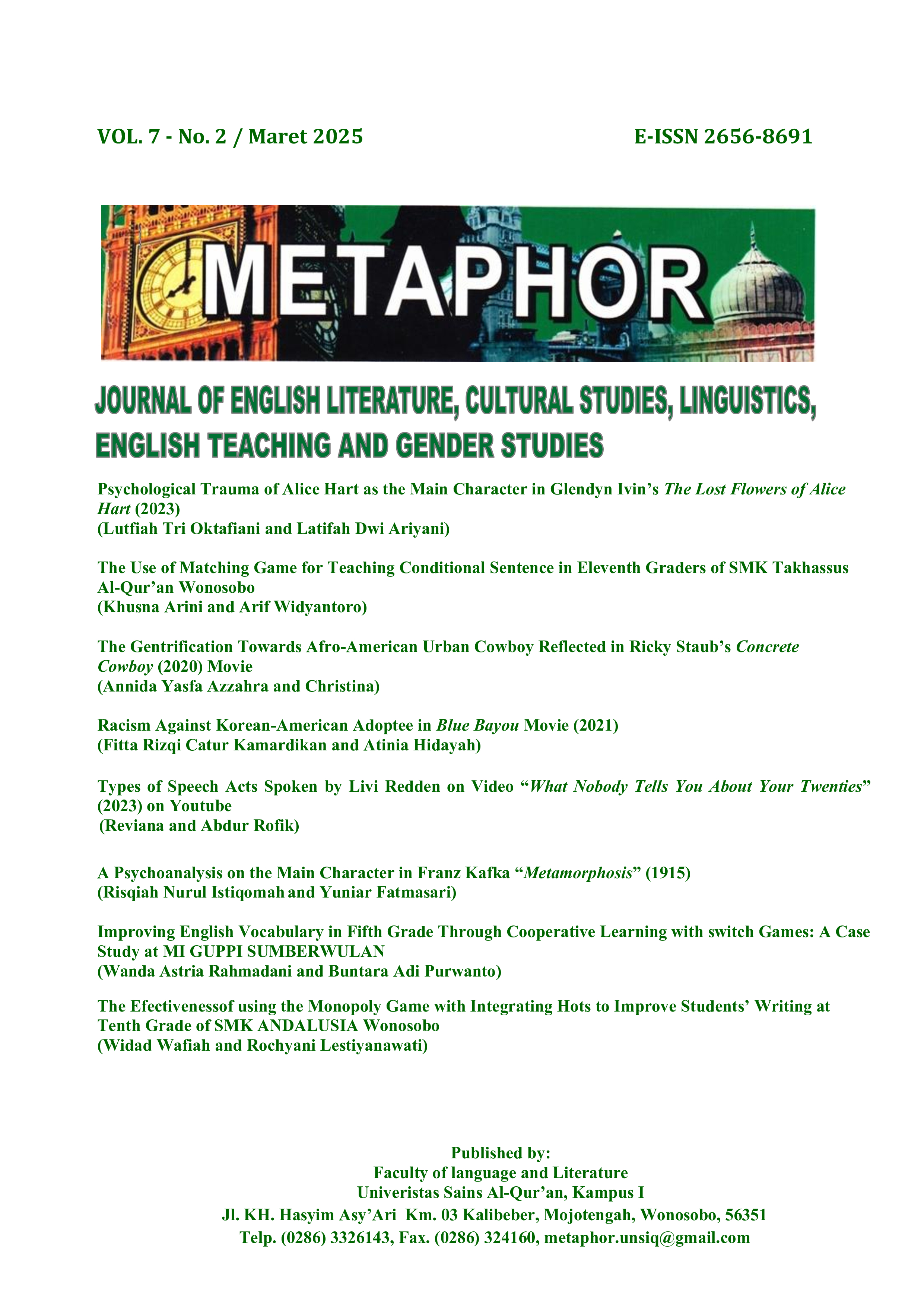The Use of Matching Game for Teaching Conditional Sentence in Eleventh Graders of SMK Takhassus Al-Qur’an Wonosobo
Keywords:
Matching Game, Conditional Sentences, CardAbstract
The aim of this research was to know whether Matching Game gives the impact or not in teaching conditional sentence at SMK Takhassus Al-Qur’an Wonosobo. The method used was classroom action research (CAR) by using qualitative and quantitative approach. The researcher used pre-cycle, cycle I and cycle II to find the data. T-test was used to analyze it. Having analyzed the data, the researcher revealed that the student’s understanding in cycle II was higher than pre-cycle and cycle I. There was positive impact in teaching conditional sentence using Matching Game at SMK Takhassus Al-Qur’an Wonosobo. The T-test result was 10.8 and T-table in degree of freedom 33 at the significant 0.05 was 2.034. The hypothesis was accepted because T-test was higher than T-table. It means that Matching Game is effective for teaching conditional sentence.
References
Ali, A. F. R. (2017). English Grammar Completed Edition (11th ed.; Nina Artanti R., ed.). yogyakarta: pustaka widyatama.
Arif Widyantoro. (2019). Teaching Conditional Sentence Using Presentation, Practice, Production (PPP) Technique in Vocational School. Journal of Culture, Literature, Linguistics, and English Teaching), 1(2), 147–164.
Arikunto, S. (2010). Penelitian Tindakan: UntukGuru, Kepala Sekolah,&Pengawas. yogyakarta: aditya media.
Azar, B. S. (1989). Understanding and Using English Grammar. United States of America: Prentice Hall Regents.
Carrillo, D. L., García, A., Laguna, T., Magán, G. R., & Moreno, J. A. (2019). Using Gamification in a Teaching Innovation Project at the University of Alcalá: A New Approach to Experimental Science Practices. Electronic Journal of E-Learning, 17, 93–106.
Creswell, J. W. (2014). Research Design Pendekatan Metode Kualitatif Kuantitatif dan Campuran Ed.4 (4th ed.). London: Sage. Retrieved from https://www.ptonline.com/articles/how-to-get-better-mfi-results.
Frank, M. (1972). Modern English : exercises for non-native speakers. Englewood Cliffs, N.J. : Prentice-Hall.
Indriyani Fitri. (2021). Teaching and Learning Irregular Verb of Simple Past Tense Through Matching Games in The First Semester of The Eighth Grade of SMP N 1 Kelumbayan Barat in The Academic Year of 2020/2021. 73.
Jill Hadfield. (1999). Beginners’ Communication Games (3rd ed.). Addition Wesley Longman: Photocopiable Material.
Juanda, A. (2016). Penelitian Tindakan Kelas (Classroom Action Research). yogyakarta: Deepublish.
Kemmis S McTaggart R. (1992). The Action Research Planner (3rd ed.). Victoria: Deakin University Press.
Kim, L. S. (1995). CVreative Game for Language Class. 33(1), 35.
Kodotchigova, M. A., & Mashamaria. (2002). Role Play in Teaching Culture: Six Quick Steps for Classroom Implementation. Internet TESL Journal, 8(7). Retrieved from http://iteslj.org/Techniques/Kodotchigova-RolePlay.html.
Ma’rifah, U., Raja, P., & Flora, F. (2022). Modified PPP Procedure in Teaching Conditional Sentences Through Whatsapp for Vocational School Students. QALAMUNA: Jurnal Pendidikan, Sosial, Dan Agama, 14(1), 133–152. https://doi.org/10.37680/qalamuna.v14i1.1462.
Murray, L. (1816). AN ENGLISH GRAMMAR.
Narayanan, R., Liu, B., & Choudhary, A. (2009). Sentiment analysis of conditional sentences. EMNLP 2009 - Proceedings of the 2009 Conference on Empirical Methods in Natural Language Processing: A Meeting of SIGDAT, a Special Interest Group of ACL, Held in Conjunction with ACL- IJCNLP 2009, (August), 180–189. https://doi.org/10.3115/1699510.1699534.
Nordby, A., Øygardslia, K., Sverdrup, U., & Sverdrup, and H. (2016). The Art of Gamification; Teaching Sustainability and System Thinking by Pervasive Game Development. The Electronic Journal of E-Learning, 14(3), 152–168.
Richards, J. C. (2006). Communicative Language Teaching Today (1st ed.). cambridge: Cambridge university press.
Rukmana, dian indra. (2019). The Use of Matching Games to Improve the Students’ Mastery on English Grammar (A Classroom Action Research at the Eleventh Grade of SMA Islam Sudirman Bringin in the Academic Year of 2018/2019) A.Retrieved from. http://e- repository.perpus.iainsalatiga.ac.id/6481/1/SKRIPSI FIX.pdf.
Sahid. (2019). Perceived Impact of Grammar Competence Toward the Speaking Ability: Focusing on the English Literature Students of Universitas Sains Alqur’an in Academic Year 2017/2018. CLLiENT (Culture, Literature, Linguistics, and English Teaching), 1(02), 198–210. https://doi.org/10.32699/cllient.v1i02.953.
Subyantoro. (2009). penelitian tindakan kelas. semarang: cv.widya karya.
Traugott, E. C., Meulen, A. Ter, Reilly, J. S., & Ferguson, C. A. (1986). On Conditionals.Cambridge University Press. https://doi.org/10.1017/CBO9780511753466



